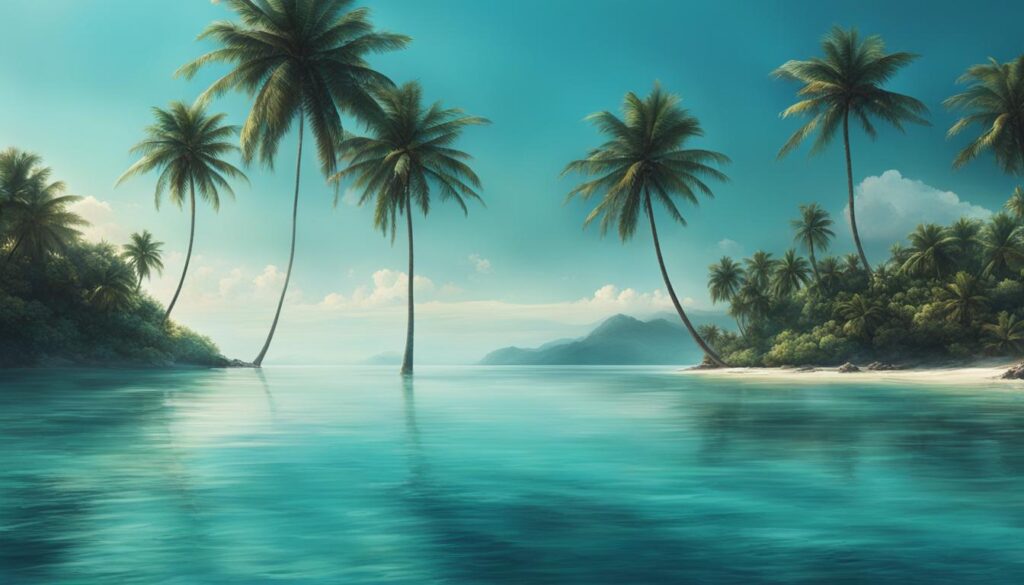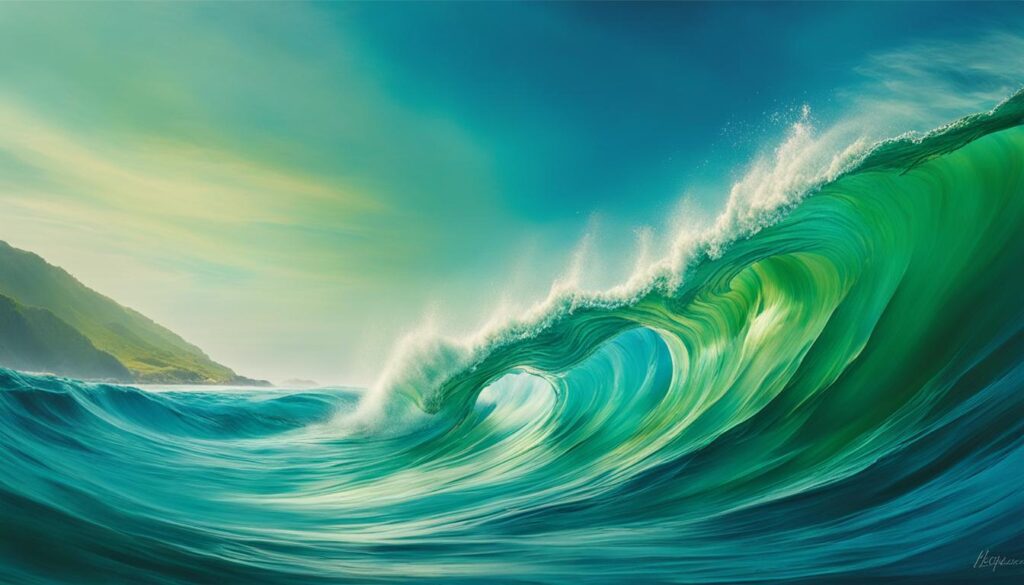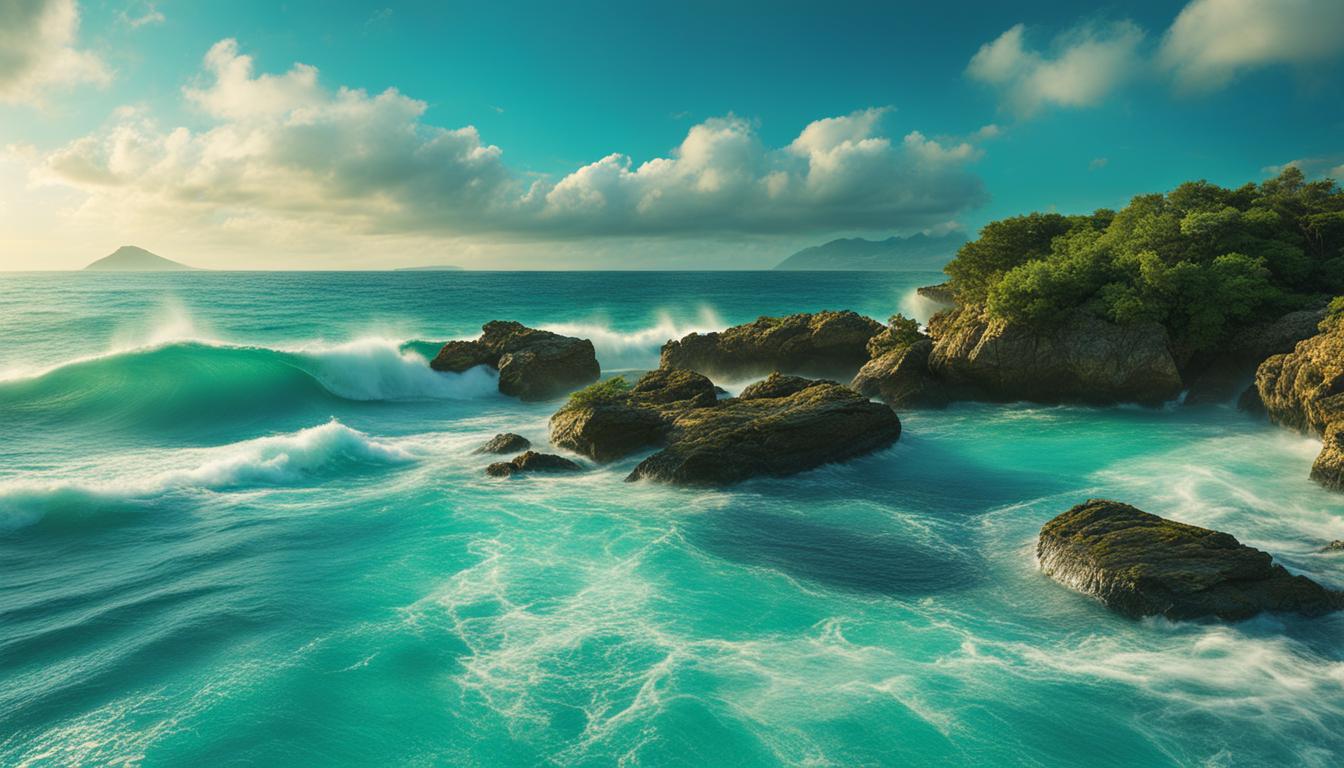Turquoise is a color that captures the imagination with its unique blend of blue and green hues. It falls between the two colors on the spectrum and is often described as a vibrant combination of the two. Imagine the waters of a tropical paradise, with their enchanting shades of blue and green. That’s the essence of turquoise.
Describing the color turquoise can be a challenge, as it encompasses a range of characteristics and visual representations. From dark turquoise to turquoise blue and light turquoise, each shade has its own distinct charm. Understanding the beauty and significance of turquoise allows us to appreciate its presence in various contexts.
Key Takeaways:
- Turquoise is a captivating blend of blue and green hues.
- Describing turquoise can be challenging due to its varied characteristics.
- Different shades of turquoise, such as dark turquoise, turquoise blue, and light turquoise, each have their own appeal.
- Understanding turquoise allows us to appreciate its beauty and significance in different contexts.
- The color turquoise symbolizes nobility, reverence for nature, and health.
The Symbolism of Turquoise in Tibetan Culture
Turquoise holds great symbolism and significance in Tibetan culture. It is considered a symbol of nobility and grandeur, dating back to ancient times when Tibetan kings wore turquoise-studded crowns. The vibrant blue-green color of turquoise is believed to represent the purity of the sky and the vastness of the ocean, reminding Tibetans of their spiritual connection to nature.
Turquoise is not only admired for its physical beauty but also revered for its association with nature. Tibetans have a deep reverence for the natural world, and turquoise is seen as a reflection of the pure waters found in the region’s sacred lakes and rivers. The stone is often referred to as “sky stone” or “heavenly stone,” further emphasizing its connection to the divine.
Furthermore, turquoise is prominently featured in Tibetan jewelry and Thangka art. In Tibetan culture, jewelry holds special significance and is believed to have protective and healing properties. Therefore, wearing turquoise jewelry is seen as a way to ward off negative energies and bring good fortune. In Thangka art, turquoise pigment is extensively used to depict deities and spiritual figures, infusing the paintings with a sense of awe and mysticism.
In Tibetan Medicine
Turquoise is also regarded as a guardian stone for health in Tibetan medicine. It is believed to have properties that promote blood circulation and alleviate eye fatigue. In Tibetan medicine, turquoise is often pulverized and used in traditional remedies, highlighting its role in enhancing well-being and healing.
The symbolism of turquoise in Tibetan culture is deeply ingrained and adds to its allure. It represents not only beauty but also spirituality, nature, and healing. Whether adorning jewelry or adorning Thangka paintings, turquoise continues to captivate and inspire with its rich symbolism and cultural significance.
The Allure of Turquoise Waters in Hawaii
The turquoise waters surrounding the Hawaiian Islands are a sight to behold. The mesmerizing hue is a result of several factors, including sunlight reflection and water clarity. The clear, pristine waters of Hawaii contribute to the stunning turquoise color that attracts visitors from around the world.
The ocean water in Hawaii appears blue because it absorbs all colors except for blue and green, which are reflected back. This creates the vibrant and captivating turquoise hue that is synonymous with the Hawaiian beaches. Additionally, the clarity of the water plays a crucial role in enhancing its color. With minimal sediment and runoff, the waters of Hawaii remain clear, allowing for a more vivid display of turquoise.
Visiting the Hawaiian beaches means immersing yourself in a world of enchanting turquoise waters. The combination of the crystal-clear ocean and the soft white sand creates a tropical paradise that is hard to resist. Whether you’re lounging on the beach or diving into the turquoise waves, the allure of Hawaii’s turquoise waters is undeniable.

Exploring the Beauty of Hawaii’s Waters
While the turquoise waters in Hawaii are undoubtedly stunning, it’s essential to remember the significance of preserving this natural wonder. Responsible tourism and conservation efforts are crucial in maintaining the clarity and allure of these waters for generations to come. By appreciating the beauty of Hawaii’s turquoise waters and supporting sustainable practices, we can ensure that this paradise remains a haven of vibrant turquoise for years to come.
The Science Behind the Blue Color of the Ocean
The color of the ocean has fascinated and intrigued humans for centuries. Have you ever wondered why the ocean appears blue? The answer lies in the behavior of light and the properties of water. Let’s dive into the science behind the mesmerizing blue color of the ocean.
Water is actually naturally blue in color, but it appears clear in small amounts due to its pale hue. When sunlight enters the ocean, it interacts with the water molecules and particles present. The blue and green wavelengths of light are not absorbed by water, but rather reflected back, creating the stunning blue color that we perceive. This phenomenon is known as Rayleigh scattering.
But what about the clarity of the water? The amount of suspended sediment and particles in the water affects its clarity. Clear water, such as in the Caribbean Sea, allows for deep visibility, while water with more sediment may appear murkier. So, even though water can be both clear and blue, the presence of suspended particles can affect its overall appearance.
Why is Ocean Water Clear but Blue?
The clarity of ocean water is influenced by its transparency and the presence of dissolved substances. Water is clear because it is a transparent medium that allows light to pass through with minimal obstruction. However, when sunlight interacts with the water molecules, the blue and green wavelengths are scattered and reflected back, giving the ocean its distinctive blue color.
To summarize, the blue color of the ocean is a result of the reflection and scattering of sunlight by water molecules and particles. The clarity of the water, as well as the presence of suspended sediment, affects the overall appearance of the ocean’s color. Next time you find yourself gazing out at the vast expanse of blue, you’ll have a deeper understanding of the science behind its mesmerizing beauty.
Sources:
- “The Science of Why the Ocean is Blue” – National Geographic
- “Rayleigh Scattering” – University of Wisconsin-Madison Department of Chemistry
- “What Makes the Ocean Blue?” – Scientific American
Exploring the Blue and Green Colors of the Atlantic Ocean
In the vast expanse of the Atlantic Ocean, one can witness an ever-changing canvas of colors, ranging from deep blue to vibrant green. The variations in color are influenced by a multitude of factors, creating a visually stunning spectacle.
The Atlantic Ocean appears blue due to the way water absorbs and reflects sunlight. Like all bodies of water, the ocean absorbs colors on the spectrum and reflects blue and green wavelengths back to our eyes. This phenomenon gives the Atlantic its characteristic blue hue, captivating the imagination of those who witness its vastness.
However, the Atlantic Ocean can also display shades of green, especially in certain areas. This variation in color can be attributed to factors such as water quality, the presence of algae or plankton, and the angle of sunlight. When the water contains higher concentrations of particles or organisms, it can take on a greener tint, creating a mesmerizing contrast to the deep blue hues.
The variation of color in the Atlantic Ocean is a testament to the dynamic nature of our planet’s waters. It serves as a reminder of the interconnectedness between sunlight, water, and the many life forms that call the ocean home.
Whether it’s the enchanting blues or the vibrant greens, the colors of the Atlantic Ocean continue to inspire and captivate us. Each visit to its shores offers a unique and awe-inspiring experience, reminding us of the beauty and wonder that lies beneath the surface.

The Enchantment of Turquoise Waters in the Caribbean
The Caribbean Sea is renowned for its stunning turquoise waters. The captivating color of the ocean is a result of the way water interacts with light. When sunlight enters the water, it is absorbed by the molecules, allowing only the blue and green wavelengths of light to be reflected back. This mesmerizing reflection gives the Caribbean Sea its vibrant turquoise hue, captivating the hearts of all who gaze upon it.
One of the reasons why ocean water appears blue in the Caribbean is due to the absence of suspended sediment. The clarity of the water allows sunlight to penetrate deep into the sea, intensifying the colors and creating a breathtaking sight. The crystal-clear waters provide a perfect window into the underwater world, revealing the colorful corals, tropical fish, and hidden treasures that lie beneath the surface.
The enchanting appearance of the turquoise waters in the Caribbean is often attributed to the pristine conditions of the region. With minimal runoff and pollution, the waters remain unclouded, allowing the true beauty of the ocean to shine through. Whether you’re lounging on a powdery white sand beach or snorkeling amidst the vibrant marine life, the turquoise waters of the Caribbean offer an unforgettable experience that will leave you in awe of nature’s wonders.
FAQ
What does the color turquoise look like?
Turquoise is a vibrant blend of blue and green hues, reminiscent of the waters of a tropical paradise.
What are the characteristics of turquoise?
Turquoise is a unique color that falls between blue and green on the color spectrum, symbolizing nobility, reverence for nature, and health.
What is the symbolism of turquoise in Tibetan culture?
Turquoise is considered a symbol of nobility and grandeur in Tibetan culture. It is also associated with nature and used extensively in Tibetan Thangka art. Additionally, turquoise is believed to have properties that promote health in Tibetan medicine.
Why are the waters in Hawaii turquoise?
The turquoise color of the waters in Hawaii is a result of the way water absorbs and reflects light. Water absorbs all colors except blue and green, which are reflected back, creating the stunning turquoise hue.
Why is the ocean blue?
The ocean appears blue because water molecules and particles in the water absorb and scatter sunlight, reflecting back the blue and green wavelengths of light.
Why does the color of the Atlantic Ocean vary?
The color of the Atlantic Ocean can vary depending on water quality, sediment, and the angle of sunlight. It can range from deep blue to greenish depending on these factors.
Why are the waters in the Caribbean turquoise?
Similar to the waters in Hawaii, the turquoise color of the waters in the Caribbean is a result of light absorption and reflection. The water absorbs all colors except blue and green, creating the vibrant turquoise hue.




